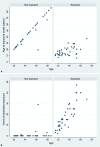More pesticides-less children?
- PMID: 31701219
- PMCID: PMC7174269
- DOI: 10.1007/s00508-019-01566-z
More pesticides-less children?
Abstract
A previously presented study investigated the impact of recent pesticide exposure on cytological signs of genotoxicity and on symptoms of intoxication in 71 male coffee workers in the Dominican Republic. An unexpected finding of this study was that conventional farming workers, among other symptoms, reported fewer children than controls working in organic farms without pesticide use. This study set out to investigate possible reasons for the latter difference. One statistical problem of this analysis is that the age of the workers is a strong predictor for the number of children and available data on the exposure determinants "duration of pesticide exposure" as well as "age at first pesticide exposure" are correlated with age. To correctly control statistics for these confounding parameters, different approaches to best control for age were explored. After careful elimination of the age-related confounding factors, a reduced number of children was still observed in exposed workers. The clearest effect is seen in those workers that reported first exposure before the age of 20 years. Socioeconomic factors could still confound that finding, but a direct effect of early life pesticide exposure is the most likely explanation of the observation.
Keywords: Coffee plantation; Farm workers; Male fertility; Non-linear associations; Pesticides.
Conflict of interest statement
H. Moshammer, M. Poteser, and H.-P. Hutter declare that they have no competing interests.
Figures




References
MeSH terms
Substances
LinkOut - more resources
Full Text Sources
Medical

